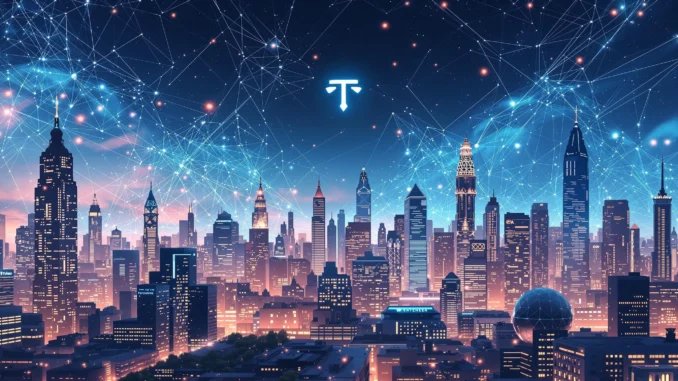
Hold onto your hats, crypto enthusiasts! Just when you thought the world of digital assets couldn’t get any more mind-blowing, Tether, the powerhouse behind the USDT stablecoin, has dropped a bombshell. They’re not just sticking to crypto anymore; they’re venturing into the fascinating realm of brain-computer interface (BCI) technology! Yes, you read that right. The company known for its stablecoins is now making waves in neurotech with the announcement of their open-source BrainOS platform. Let’s dive deep into what this groundbreaking move means for the future of technology and, of course, for the crypto space.
What is Tether’s BrainOS and Why Should You Care About Brain-Computer Interface?
So, what exactly is BrainOS, and why is Tether, a stablecoin issuer, suddenly interested in helping us connect our brains to computers? Essentially, a brain-computer interface is a technology that allows direct communication between the brain and an external device, like a computer. Think of it as bypassing the usual input methods like keyboards and mice and controlling technology directly with your thoughts. Sounds like science fiction? It’s becoming reality, and Tether wants to be at the forefront of this revolution.
Here’s a breakdown of why this is a big deal:
- Decentralization in Neurotech: Tether is championing an open-source approach with BrainOS. This is crucial because it aims to prevent the monopolization of BCI technology by a few large corporations, fostering innovation and accessibility for everyone.
- Transparency and Collaboration: Open-source means the code for BrainOS will be publicly available. This encourages transparency, allowing researchers, developers, and even patients to contribute, scrutinize, and improve the platform.
- Building on Existing Expertise: Tether’s investment in BlackRock Neurotech, a company already making tangible progress in BCI with devices used by patients globally, isn’t just a random venture. It’s a strategic move leveraging existing expertise and real-world applications.
- Expanding the Crypto Ecosystem: While seemingly unrelated, Tether’s foray into neurotechnology could broaden the applications of blockchain and cryptocurrency principles into new domains. Imagine decentralized data management for brain data, or crypto-based incentives for BCI research.
Tether and BlackRock Neurotech: A Powerful Partnership in BCI
Tether’s commitment to Brain-Computer Interface development isn’t just lip service. Their substantial $200 million investment in BlackRock Neurotech last year underscores their serious intentions. BlackRock Neurotech is not a newcomer to the BCI scene; they’ve been developing and deploying implantable devices that are already changing lives.
What makes BlackRock Neurotech significant?
| Feature | Description |
|---|---|
| Real-world Application | BlackRock Neurotech’s devices are currently used by dozens of patients worldwide, helping them regain lost functions like movement and communication. |
| Proven Technology | They have developed advanced implantable BCI systems that have shown tangible results in clinical settings. |
| Synergy with Tether’s Vision | BlackRock Neurotech’s focus on practical BCI solutions aligns perfectly with Tether’s ambition to make neurotechnology more accessible and decentralized through BrainOS. |
This partnership isn’t just about funding; it’s about combining Tether’s resources and vision with BlackRock Neurotech’s proven technology to accelerate the development and adoption of brain-computer interfaces.
The Open-Source Advantage: Why BrainOS Could Be a Game Changer for Neurotechnology
Why is Tether emphasizing the open-source nature of BrainOS? In the tech world, ‘open-source’ is often synonymous with ‘innovation,’ ‘community-driven,’ and ‘rapid development.’ For neurotechnology, especially brain-computer interfaces, an open-source approach carries several key benefits:
- Accelerated Innovation: By making BrainOS open-source, Tether is inviting a global community of developers, researchers, and enthusiasts to contribute. This collaborative environment can lead to faster innovation and the discovery of unforeseen applications.
- Reduced Development Costs: Open-source projects benefit from shared resources and collaborative effort, potentially lowering the overall cost of developing and deploying BCI technology. This could make it more accessible to a wider range of users and researchers.
- Enhanced Security and Trust: In sensitive fields like neurotechnology, transparency is paramount. Open-source code can be scrutinized by many eyes, leading to the identification and rectification of vulnerabilities, fostering greater trust in the technology.
- Customization and Adaptability: An open-source platform like BrainOS can be adapted and customized to suit diverse needs and research objectives. This flexibility is crucial in a rapidly evolving field like BCI.
What are the Potential Applications of Tether’s BrainOS Platform?
The potential applications of a robust, open-source brain-computer interface platform like BrainOS are vast and span across various sectors. Let’s explore some exciting possibilities:
- Healthcare Revolution: BCIs can dramatically improve the lives of individuals with paralysis, neurological disorders, and amputations. BrainOS could power advanced prosthetic limbs, restore communication for people with locked-in syndrome, and offer new therapies for conditions like epilepsy and Parkinson’s disease.
- Enhanced Human-Computer Interaction: Beyond medical applications, BCIs could revolutionize how we interact with technology. Imagine controlling your devices, navigating virtual reality, or even communicating with others telepathically – all through thought.
- Research and Scientific Discovery: BrainOS can serve as a powerful tool for neuroscience research, allowing scientists to gain deeper insights into brain function, consciousness, and neurological disorders. This could lead to breakthroughs in understanding and treating brain-related conditions.
- Gaming and Entertainment: The gaming industry is always looking for the next level of immersion. BCIs could offer incredibly intuitive and immersive gaming experiences, where players control games directly with their minds.
Challenges and Ethical Considerations in Brain-Computer Interface Development
While the potential of brain-computer interfaces and platforms like BrainOS is immense, it’s crucial to acknowledge the challenges and ethical considerations that come with this powerful technology:
- Technical Complexity: Developing reliable and safe brain-computer interfaces is incredibly complex. Challenges include signal processing, biocompatibility of implants, and long-term device stability.
- Data Security and Privacy: Brain data is incredibly sensitive. Ensuring the security and privacy of this data is paramount. Open-source platforms, while transparent, must also incorporate robust security measures to prevent misuse and breaches.
- Ethical Dilemmas: As BCIs become more sophisticated, ethical questions arise regarding cognitive enhancement, mind control, and the very definition of human identity. Open and public discussions are needed to navigate these complex ethical landscapes.
- Accessibility and Equity: Ensuring that BCI technology, including platforms like BrainOS, is accessible to all who need it, and not just the privileged few, is a critical challenge. Open-source initiatives can play a vital role in promoting equity and wider access.
Tether’s Vision: Decentralizing the Future of Neurotechnology
Tether’s move into brain-computer interface technology with BrainOS is a bold and potentially transformative step. By championing an open-source approach and investing in companies like BlackRock Neurotech, Tether is signaling a commitment to democratizing access to neurotechnology. While the journey of BrainOS is just beginning, it represents a significant moment in the convergence of cryptocurrency principles and cutting-edge scientific innovation.
Is this a surprising move from a stablecoin issuer? Perhaps. But in the rapidly evolving landscape of technology, where boundaries are blurring and innovation is paramount, Tether’s venture into brain-computer interfaces could be a visionary leap that reshapes not just the crypto world, but the future of human-computer interaction itself. Keep an eye on BrainOS – it might just be the platform that unlocks the next frontier of human potential.



